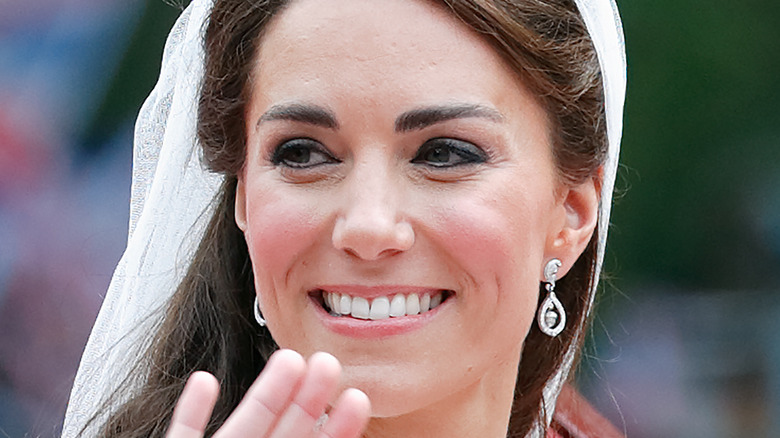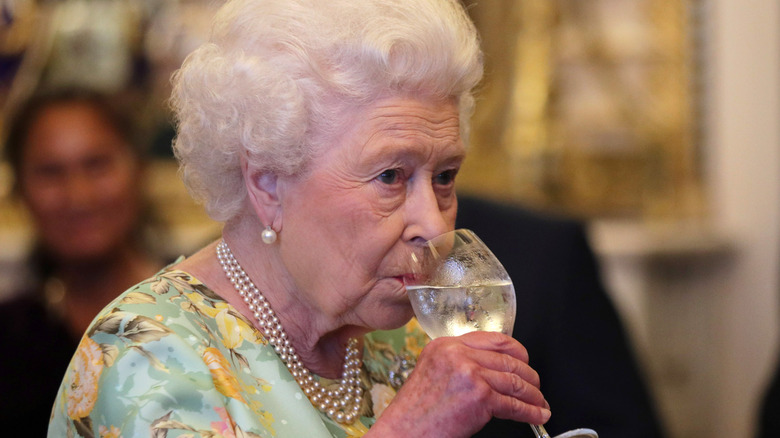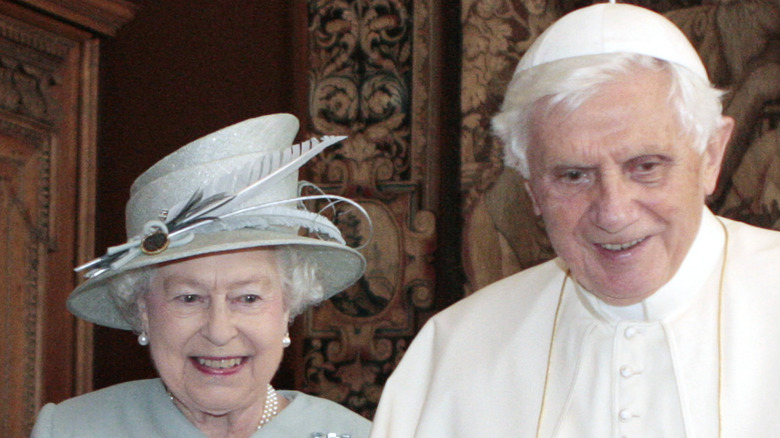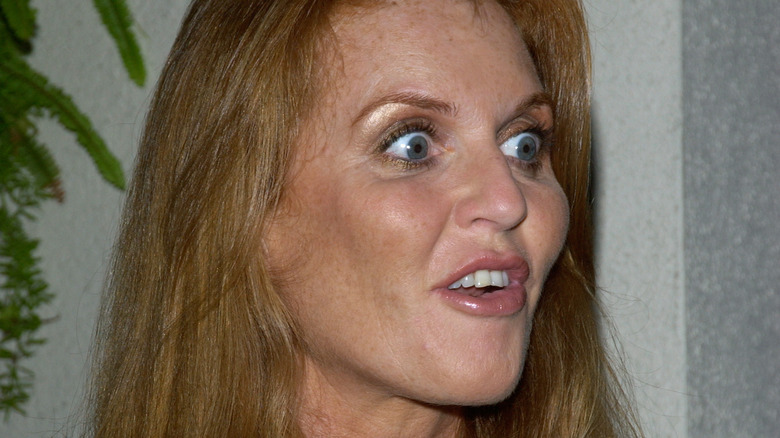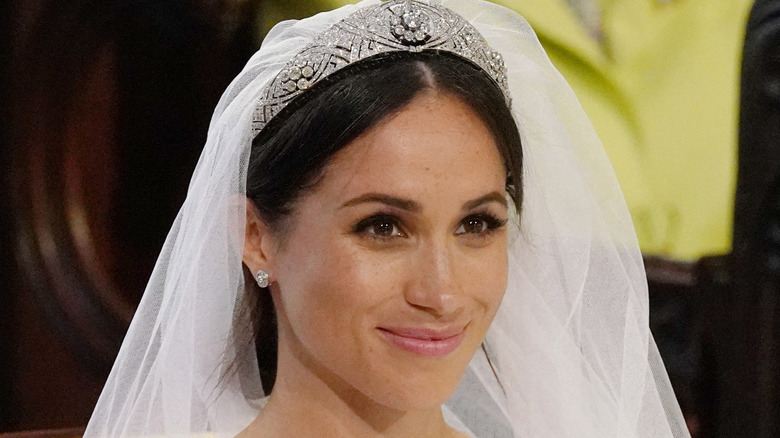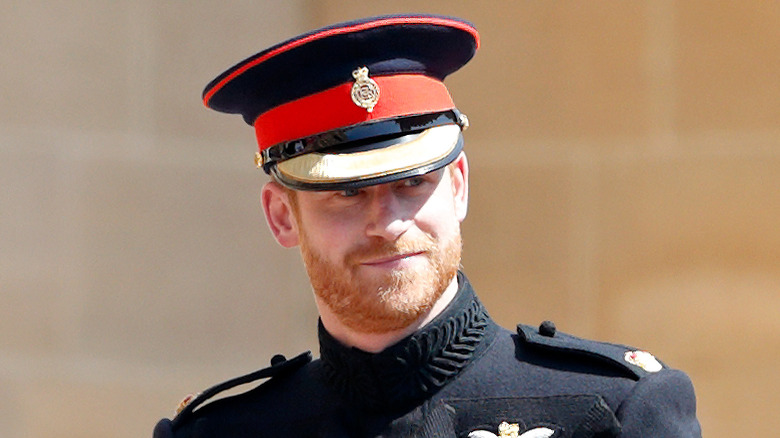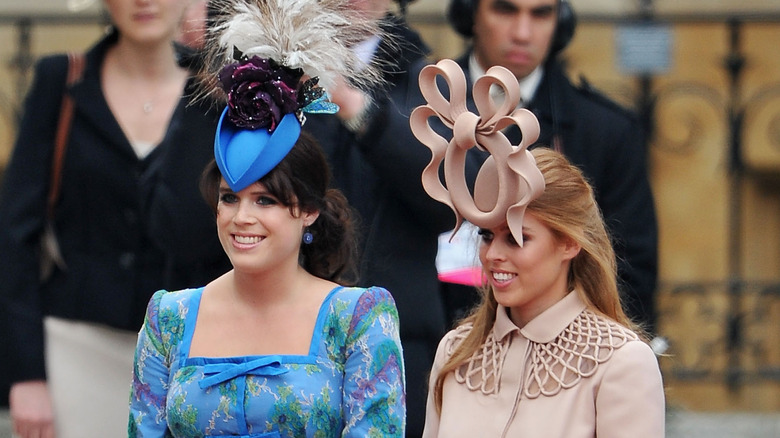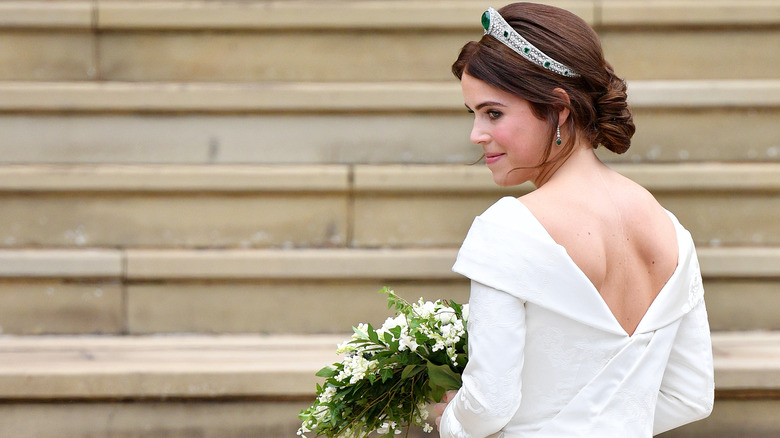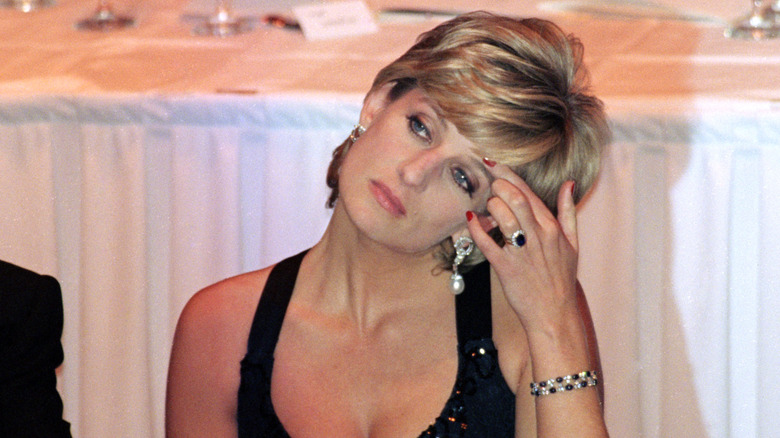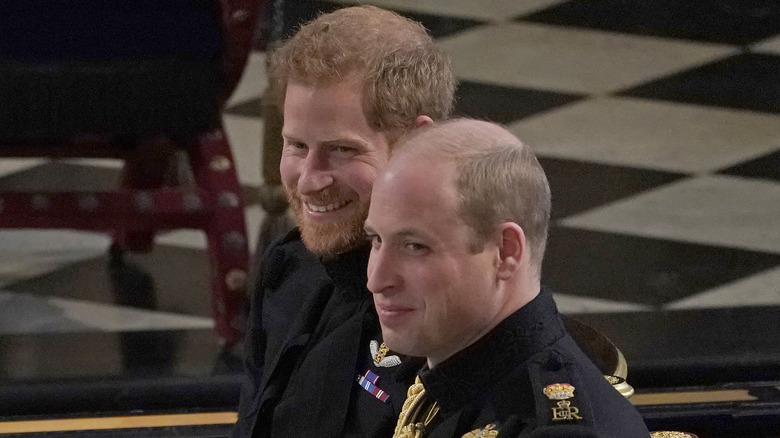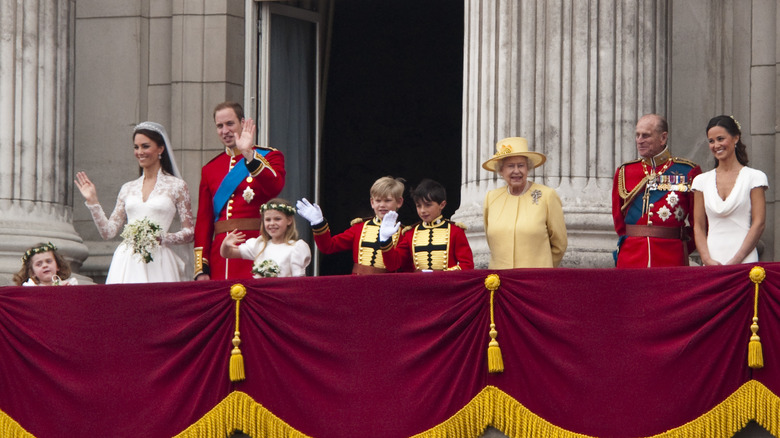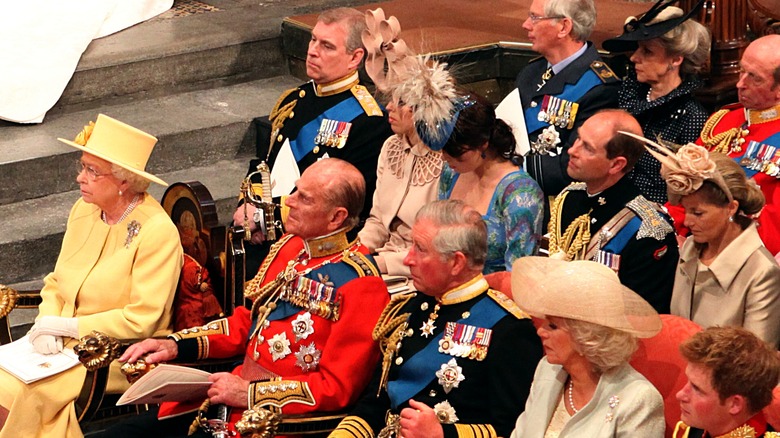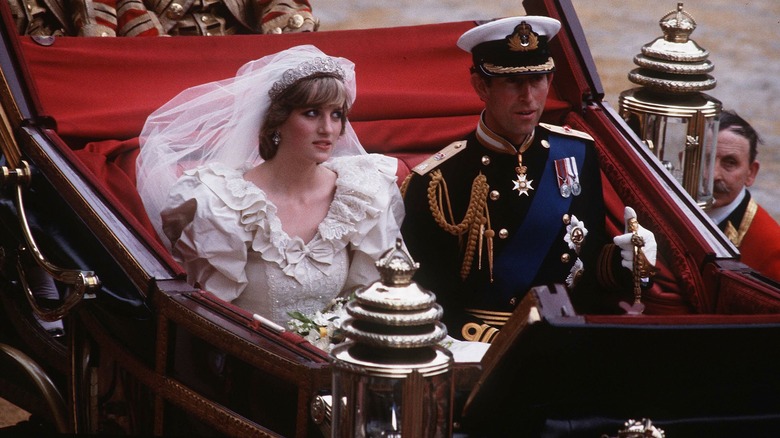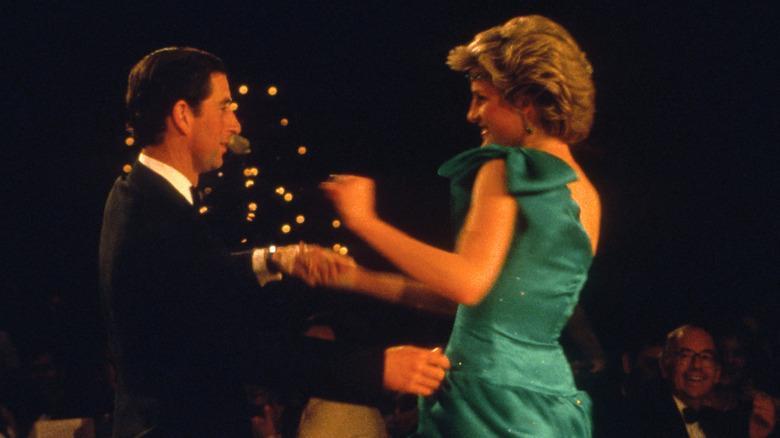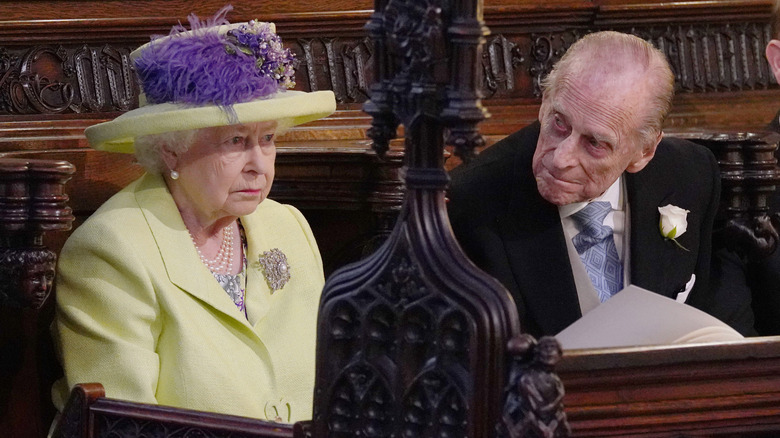Wedding Rules The Royal Family Has To Follow
The US parted ways with Britain in 1776 after declaring independence, one year into the American Revolution, per History.com. Colonists resented paying taxes to their colonial overlords. They didn't care for the Brits' hot, milky tea too much either — definitely not in Boston, anyway. Also, King George III wasn't exactly a fan favorite. Per PBS, he was considered mad and viewed as a tyrant by many.
Fast forward 245 years and the U.S. has shifted from dissing to digging the monarchy. According to a YouGovAmerica survey, 68% of citizens "hold a favorable view" of Queen Elizabeth II. Her middle son? not so much — for obvious and extremely shady reasons, Prince Andrew doesn't have a huge fan club. Along with the recently developed positive vibes, there's also a degree of fascination, curiosity, bewilderment, and even ridicule surrounding the royal family.
Seeing "The Firm" in action is akin to watching a trainwrecktastic reality show that you just can't switch off. And there's no better opportunity to get your gawk on than during a good old royal wedding. The U.S. public can't get enough of them, with a whopping 29.19 million tuning in to watch Prince Harry and Meghan Markle walk down the aisle, per Statista. Pomp, entitlement, antiquated etiquette, and a long, long list of rules go gloved hand in gloved hand with a royal marriage ceremony. Dust off the Marmite, old chap, and pop the kettle on — we're drawing the curtains back to reveal wedding rules the royal family has to follow.
Getting the boss's blessing
Marrying into the royal family is like marrying into the mob — well, kind of. On one hand, you get to ride (a lot) of horses instead of waking up next to their severed heads. On the other, you take a monarchal-version omertà and have to ask The Boss for their blessing if you want to get wed.
The Royal Marriages Act of 1772 decreed that all members of the monarchy must request the reigning sovereign's permission, in writing no less, before proposing marriage. If the crowned head said no, all wedding bets were off, unless the rejected royal went rogue and became a "commoner" — giving up their privileges, status, public income, and inherited assets, along with relinquishing any potential future claims to the throne.
The act was repealed in 2015, per Legislation.gov.uk, making it no longer a mandated requirement under British law to be granted permission to wed. However, per Town and Country, The Firm still enforces a strict rule that family members must request the queen's blessing to marry — but only the important ones. Lesser royals, such as Princess Eugenie, who's ninth in line to the throne (at the time of posting), are free to marry whoever their heart desires. Eugenie, the daughter of Prince Andrew and Sarah Ferguson, chose to wed her distant cousin, Jack Brooksbank, aka "Barman Jack." According to the Daily Mail, Brooksbank's grandmother described her Mayfair bar-hopping socialite offspring as nice "but not the most intelligent."
Royal wedding Catholic considerations
When Henry VIII became King, England was devoutly Catholic. However, that all changed after Pope Clement VII refused multiple requests by the spousal serial killer — and, according to Sky News, certified psychopath — to annul the marriage to his first unfortunate wife. Per Smithsonian magazine, the king of England was still determined to make a marital "upgrade" come hell or holy high water. Unfortunately for Henry, however, Catherine of Aragon was too powerful to murder, so he decided to off the pope instead (without removing his head).
Henry created the Church of England and promptly declared himself the supreme head honcho. He granted himself a divorce and married his second (even more) unfortunate wife, Anne Boleyn. Any peasants who dared to object were tied to a stake and burned to death or "hanged, drawn, and quartered." Powerful or noble detractors were privileged enough to have their heads chopped off instead, as poor Anne did too when Henry inevitably became bored of her (via History.co.uk).
Per People, England would never return to the Church of Rome, aside from during the brief rule of the fervently Catholic Queen Mary — who was nicknamed "Bloody Mary" because of the masses of Protestants she gruesomely murdered. To ensure the future of the Church of England, royals were forbidden from marrying Catholics. It took until 2015 for the law to be changed. However, although royals can now marry Catholics, any offspring who enter the religion are forbidden from inheriting the throne.
Royal terror training
Entering into the ranks of the British royal family has to be terrifying enough in itself without the added stress of a wedding on top — especially a wedding that will be broadcast on live TV and watched by millions of people worldwide. So, to try and prepare non-royals for their big day and ensuing life in the public spotlight, brides-to-be have to undergo a rigorous training regimen.
How rigorous is rigorous? Well, according to The Telegraph, in addition to being coached on everything etiquette-related — like how to sit, stand, curtsey, talk, smile, wave, drink tea, and dress — The Firm's appointees-in-waiting also undergo terrorism training by Britain's elite military special forces, the SAS. According to the book "Finding Freedom" (via Tatler), Meghan's training was pretty intense. "Meghan took part in a staged kidnapping, where she was bundled up in a car by a 'terrorist,' taken to a different location, and then 'saved' by officers firing fake guns (the kind used in Hollywood films) for realism," wrote authors Carolyn Durand and Omid Scobie. She also allegedly learned how to engage with her captors.
However, as Meghan, Diana Spencer, Sarah Ferguson, and many others learned the hard way, no amount of training can ever really prepare you for what's to come. "I can very safely say, as naive as it sounds now ... I did not have any understanding of just what [royal life] would be like," Meghan admitted to BBC News.
Dress demands
All royal brides abide by a dress code. Per Cosmopolitan, picking a white gown is a must — all white with no color accents. SCMP reports that the color mandate traces back to 1840 when Queen Victoria tied the knot with Prince Albert of Saxe-Coburg and Gotha. However, Wallis Simpson broke the rule in 1937. The U.S. divorcée wore a blue "column dress" for her marriage to then-heir to the throne, Prince Edward, and, well, we all know how that turned out.
A local British fashionista must design and make the gown to reflect the bride's respect for queen and country. In addition, according to Hello!, low necklines are frowned upon; dresses must cover the shoulders and be full length — even showing off knees is a no-no. And, to be sure that all rules are followed to the tee, the queen must grant her approval before the gown can even start being made.
But that's not all. The bride must also wear a tiara, and, not surprisingly, that comes with its own set of rules, too. It's mandatory to make an appointment with the queen to select a tiara from her extensive coronet collection. However, options are limited, as her majesty picks out the ones she deems suitable for the bride to choose from, according to Marie Claire. And you thought your future mother-in-law was a pain in the proverbial.
Royal groom military orders
Royal grooms are also heavily regulated when it comes to their wedding attire choices. It's become a tradition for any male born within The Firm's inner sanctuary to wear a military uniform for the ceremony. The monarchy maintains close ties with the armed forces, with all of the queen's male offspring performing at least one term of military service.
Prince Charles served in the Royal Air Force. Per BBC News, Prince Andrew, The Duke of York, was in the Royal Navy for 22 years and served during the Falklands war, which resulted in the highly questionable claim that for a long period of time he lost the ability to sweat. However, Prince Andrew's cringeworthy BBC Newsnight interview definitely showed that he appears to have zero issues nowadays when it comes to sweating. Prince Edward, The Earl of Wessex, chose to enter the Royal Marines, albeit just for a brief stint. Prince William underwent training with the Royal Navy and the British Army before joining the RAF and serving as a search-and-rescue pilot for three years. And Prince Harry, The Duke of Sussex, underwent two tours of Afghanistan during his 10-year stint in the British Army.
According to the Los Angeles Times, royal grooms are kitted out by Savile Row's Gieves & Hawkes. The luxury tailors have been making the monarchy's male members' wedding uniforms "and formal attire for centuries." They were granted the status of being the "official supplier to the crown" by King George III back in the 1700s.
Royal wedding guest dress code
Being invited to a wedding is always the perfect excuse for dusting off the credit cards and splashing out for a fab new outfit. However, if you happen to be one of the privileged elite who's been invited to attend a wedding hosted by members of The Firm, you better choose that outfit carefully.
All of the royal wedding guests are subjected to strict rules concerning the dress code –- because, of course they are, you plebs; it's the British monarchy. Per Marie Claire, it's compulsory for women to wear a hat. And not just any old hat — ludicrous and over-the-top are the millinery order of the day. Two unforgettable examples are the fantastical fascinators that Princesses Beatrice and Eugenie wore to William and Kate's 2011 nuptials.
According to Brides.com, good tailoring, "long hemlines and modesty are key" for women's dresses. But they can be of any color, aside from black or white, and the brighter, the better. Male guests don't escape royal wedding rules either. Gentlemen are ordered to wear military uniforms, "lounge" attire, or "morning dress," which, no, doesn't constitute PJs and slippers. Lounge attire equates to tailored, dark-colored, business-style suits. Morning dress comprises a suit with tails. However, men get to choose whether to cover their heads or not as top hats are deemed "optional."
Royal bride flower formalities
Even the royal wedding bouquet is subject to formalities and strict rules that must be adhered to. According to Hello!, the bride-to-be is granted the freedom of deciding what kind of blooms she carries down the aisle. It usually comprises her favorites combined with flowers that have sentimental value. However, the freedom ends right there.
Royal wedding rules dictate that "sprigs of myrtle" must be inserted into all bridal bouquets. Per Britannica, the green shrub with fragrant white flowers grows throughout the southern region of England, and it's been around for centuries. The Ancient Greeks incorporated sprigs into "wreaths and other decorations" as a sacred symbol of love. Queen Victoria's daughter, Victoria, Princess Royal, was the first to include myrtle in her bouquet when she married Prince Friedrich Wilhelm of Prussia in 1858. It's been a mandatory staple of royal bouquets ever since. Each bride's sprig is picked from the myrtle plant Queen Victoria was given by her husband Prince Albert's grandmother.
Following the ceremony, royal brides don't toss the bouquet over their shoulder like us commoners do. The Daily Mail reports that instead the flowers are taken and laid on the Grave of the Unknown Warrior, which is located inside Westminster Abbey. The tradition dates back to 1923 when Queen Elizabeth II's mother married the future British King, George VI. Lilibet left her bouquet on the grave in honor of her brother Fergus, who died during World War I.
Royal wedding ring regulations
The royals are allowed free range for engagement rings –- well, as long as they come from a crown-approved jeweler such as Garrard, per Brides.com. A royal's every move is usually controlled by strict rules to ensure they don't fall short of The Firm's high standards. So, it's little surprise that their decisions often result in disapproval when they use their own free will.
According to Vogue, after Prince Charles proposed to Lady Diana Spencer, he presented her with a range of Garrard engagement rings to choose from. She settled on a white gold band with a 12-carat oval sapphire and 14 diamonds. The ring is iconic and beloved –- especially since becoming Kate Middleton's. But, when it came to the queen, "one was not amused" by Diana's selection. Royal feathers were ruffled because the ring wasn't bespoke. It even featured in a Garrard catalog –- meaning any old commoner (with $60,000 going spare) could buy the same one.
Preventing other such indignities and humiliations from occurring, the rules are firmly in place when it comes to the bride's royal wedding ring. Per WalesOnline, all bridal wedding bands must be made from Welsh gold, a tradition dating back to 1923 when the Queen Mother married the future-King George VI. The same nugget of gold used to make the Queen Mother's ring was also crafted into wedding bands for Princess Margaret, Princess Anne, and Princess Diana before presumably there was nothing left.
Royal wedding bestie ban
The royal family is most definitely not just like us. It's pretty safe to say that at least 99 percent of us don't own castles or have an invaluable hoard of solid gold glittering tiaras, gigantic diamonds, and other assorted precious gems squirreled away in a tightly guarded vault, let alone possess a vast collection of matching twin sets, pearls, and "fascinators."
Also, it's traditional for male members of the hoi polloi to have a best man by their side on their wedding day. The best man plays an essential role — without him, how else would a groom-to-be end up passed out in a shady Las Vegas strip club at 5 a.m. during his bachelor party? And wake up with a perma-ink fake mustache drawn on his top lip?
However, the royal family eschews commoners' wedding traditions and doesn't usually have a "best man." Instead, the groom-to-be has "supporters," per the Express. The groom's supporters basically act in the exact same capacity as a best man, just with a posher title and minus any perma-ink pens. However, per Hello!, one royal who surprisingly broke the rule was the usually reliably stoic, vanilla, and conservative future king of the United Kingdom, Prince William. Wills threw caution to the traditional royal wedding wind and named his little bro, Harry, as his official "best man" for his and Kate Middleton's April 2011 nuptials.
Royal wedding elitism and age limits
It's all about age and elitism when it comes to royal wedding party rules. Brides.com (via Reader's Digest) reports that bridesmaids have traditionally been between 10 and 12 years old. But they've been getting younger over the years — allowing for way cuter photo ops.
According to Good Housekeeping, before she became queen, 9-year-old Elizabeth Windsor was one of eight young bridesmaids at the Duke of Gloucester's marriage to Princess Alice. Princess Anne was also 9 when she and seven other children accompanied Princess Margaret down the aisle. And 5-year-old Prince Harry was a "cheeky pageboy" at Viscount Althorp's wedding. However, per Hello!, Prince William and Kate Middleton lowered the age bar by including a 3-year-old in their prepubescent party of six. Then, Harry and Meghan ramped it down further, with ten attendants aged between 2 and 7 years old (via CBS News).
Traditionally, the bride and groom's wedding party comprises royal offspring and assorted members of the aristocracy. However, all bets are off when it comes to The Firm's outsider wedding rules. The Duchess of Cambridge was forbidden from being the maid of honor at her sister's 2017 ceremony. "[It would be unbecoming] for a member of the royal family to walk behind a commoner — which, as painful as that sounds and despite being directly related to Catherine, is what Pippa is," etiquette expert William Hanson told Cosmopolitan.
Royal seating and eating
There are multiple etiquette rules concerning royal interactions, with the queen racking up the highest number. The seemingly endless list includes never touching the anointed one (Oopsie Michelle Obama), "stand[ing] to attention" when the Maj enters and remaining so until she sits down, never speaking unless you're spoken to first, and bowing or curtsying upon meeting, per the Mirror.
Even weddings don't allow for protocol breaches, so don't even think of going in for a hug after too many glasses of champers –- even if old Liz is now an in-law. Per Cosmopolitan, a strict seating policy ensures minimum interactions with commoners during the ceremony. Royals always sit on the church's right side and non-royals on the left. Also, each guest is allocated a numbered seat to help maintain the social pecking order.
There's no relaxing of the rules during the ensuing receptions. Advancing With Style reports that guests must remain standing behind their chairs until the Boss enters and sits. Nobody can eat until the queen starts, and when she stops, everyone else must too, regardless of whether they've finished or not. Diners must position their knife and fork parallel to each other at the 6 o'clock position when finished. Oh, and if you have a weak bladder, you're going to be in trouble. It's considered a serious faux pas to leave the table during dinner -– so make sure you embark on a pre-wedding kegel exercise regime, ladies.
Two wedding receptions and a ceremony
Everything about the actual royal wedding day is regulated and run like a military operation, with an accompanying rule book that's almost as long as "War and Peace." Included among the many protocols, conventions, and customs that must be adhered to are rules about what time the ceremony occurs and how many receptions accompany it, per Marie Claire.
As GMA reports, royal weddings are conducted early in the day, with the majority kicking off at noon. The ceremony is followed by a total of two receptions. The newlyweds are whisked away in a horse-drawn carriage, following the obligatory balcony waving photo opp, to join their guests at the first soiree — which is officially called a "wedding breakfast," even though there's not a slice of toast or a poached egg to be seen. Instead, according to Harper's Bazaar, the 600 guests who attended Meghan and Harry's wedding breakfast of champions were served "Pol Roger Champagne along with canapés and bowl food."
The second reception is a more intimate affair, allowing the happy couple to really let loose, well, by royal standards anyway. It occurs in the evening and is attended by family and close friends. A formal three-course dinner is served, the obligatory speeches are made, a DJ spins some tunes, the queen busts out with some of her best moves (probably), and a firework display rounds off the festivities.
Royal wedding conga customs
When you think of the royal family, the last thing that springs to mind is dancing and partying hard –- with the exception of Prince Harry, as he more than proved in Las Vegas. And, of course, Princess Diana, who loved to get her groove on whenever possible (John Travolta, anyone?)
However, The Cut claims the monarchy is all about the conga after they've downed a bottle or two of Bolly. Yep, really. The royal dance favorite dates back to King George VI's reign in the 1930s, when he would habitually finish off festivities with a good old conga –- well, it was pre-Village People "Y.M.C.A" days. The conga-loving king apparently led a long line of revelers around Buckingham Palace on the eve of his daughter's wedding. The royal family has continued the tradition throughout the years. The teenage Princesses Elizabeth and Margaret conga'd even through the Ritz Hotel to celebrate VE Day with the common people in 1945.
And, according to the Daily Mail, as the champers flowed and the festivities ramped up a notch, Charles and Diana's 1981 wedding reception resulted in "twisting, snaking congas, all accompanied by whoops and yells from the royal siblings." No word on how many guests — which included Princess Grace of Monaco and first lady Nancy Reagan — joined the line. However, interior designer Nicky Haslam writes, "Stumbling out into the early dawn, I knew I could hardly hope to witness so extraordinary an event ever again."
Picking up the check
Weddings don't come cheap these days. Bridebook estimates an average Joe's run-of-the-mill wedding costs in the region of £24,000 (which equates to approximately $32,000). For obvious reasons, a royal wedding is a bazillion times more expensive. William and Kate's big day back in 2011 cost around $34 million, per CNN, while Harry and Meghan's 2018 nuptials upped the ante to somewhere in the $42.2 million range, according to Bridebook.
The British monarchy has scaled down on expenses, as unbelievable as that may seem. ABC News estimates that after adjusting for inflation, Charles and Diana's 1981 wedding would cost an eye-watering $110 million in today's terms. However, scaled-down or not, a royal wedding will always be hella spendy -– and tradition dictates that the monarchy picks up the check. Although, in reality, that's actually not the case at all.
"The royal family will pay for the core aspects of [Meghan and Harry's] wedding, such as the church service, the associated music, flowers, decorations, and the reception," Kensington Palace revealed in a statement. As CNN Money points out, this still leaves the vast bulk of expenses uncovered, although it's believed Markle paid for her wedding dress. Not surprisingly, the royal family has kept schtum on the subject. But, according to Bridebook, the security bill for the wedding would have been higher than the £30 million ($39.7 million) William and Kate's cost. And, that part is paid — in full — by all of the commoners who comprise the British public.

